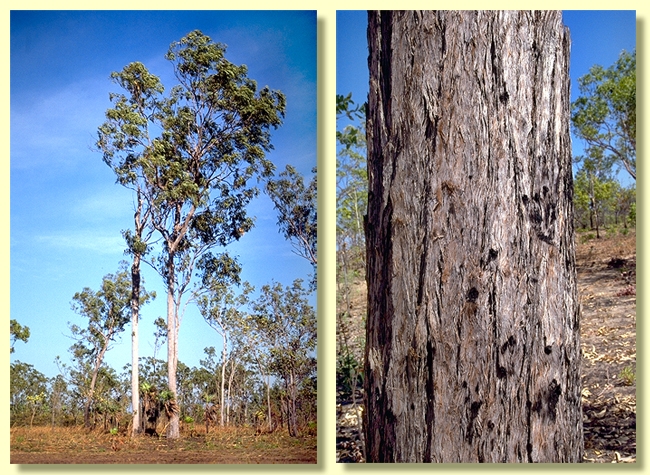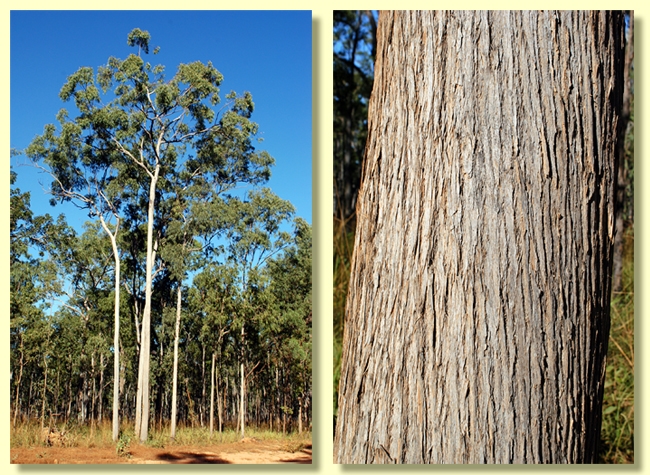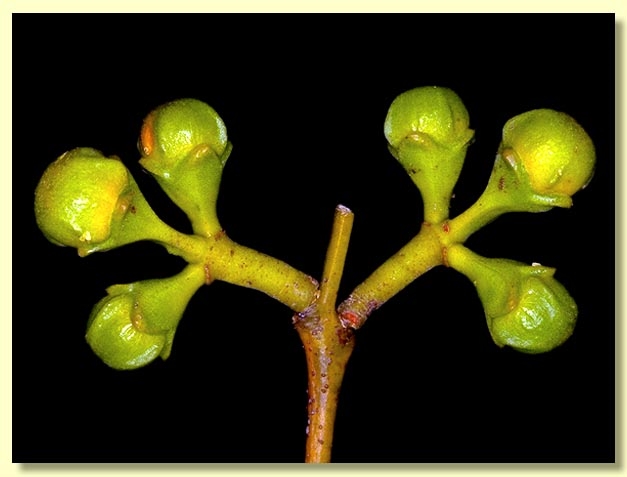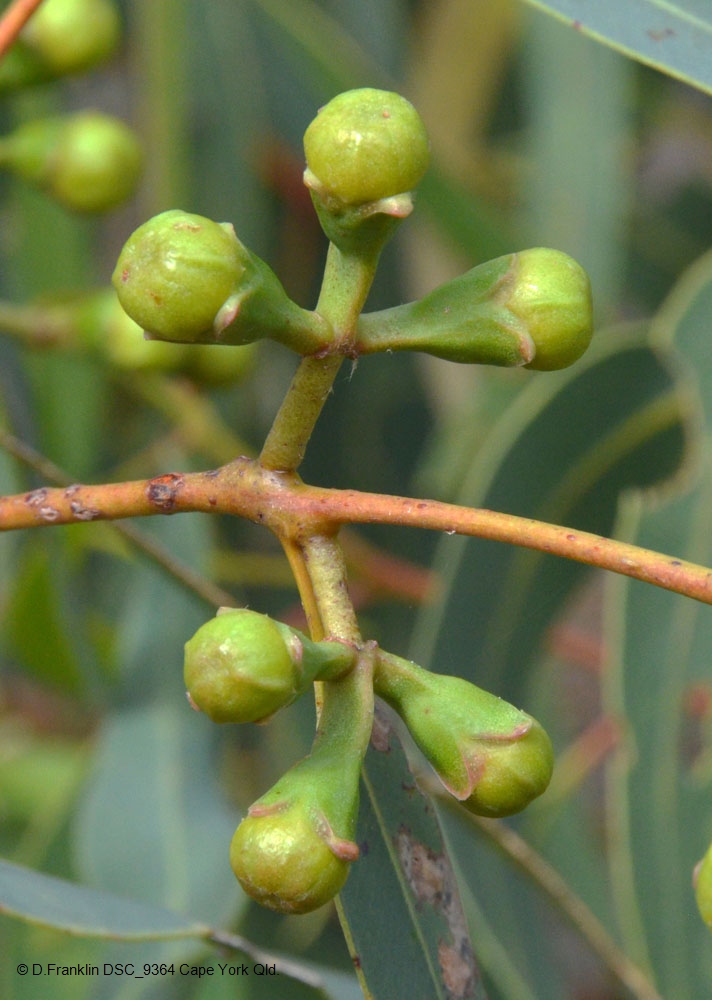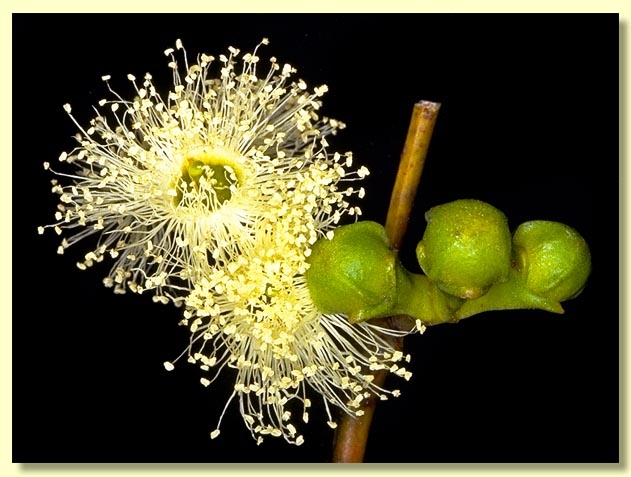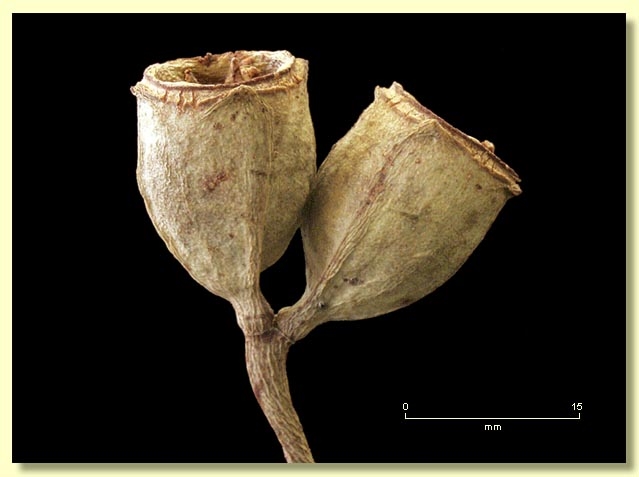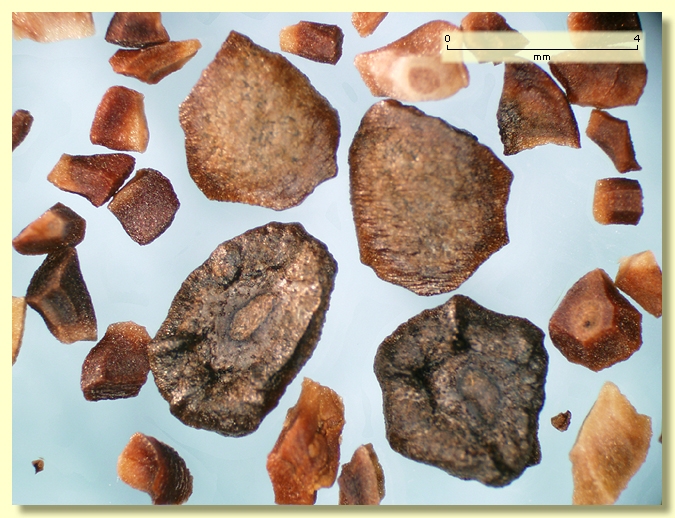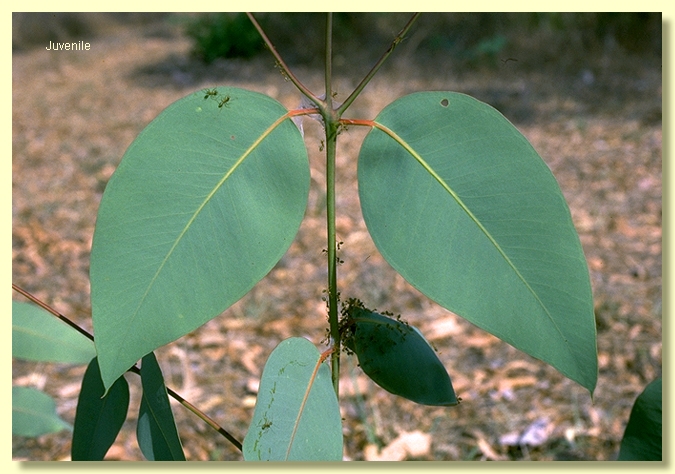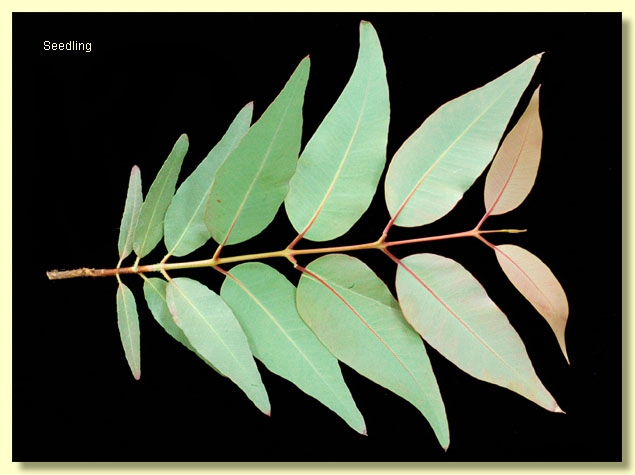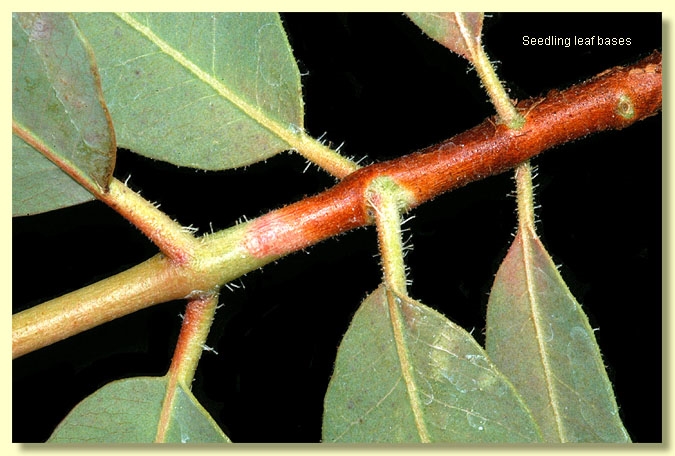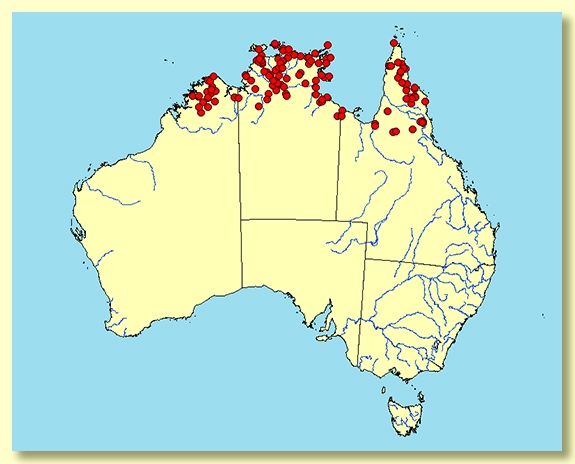Euclid - Online edition
Eucalyptus tetrodonta
Eucalyptus | Eudesmia | Complanatae
Eucalyptus tetrodonta F.Muell., J. Proc. Linn. Soc., Bot. 3: 97 (1859).
T: entrance to Victoria River, Northern Territory, Sept 1855, F.Mueller; lecto: MEL [fide Maiden, Crit. Revis. Eucalyptus 5 (139-140) 1921 and also Hill & Johnson, Telopea 7 (4) 404 (1998)].
Tree to 25 m tall. Forming a lignotuber, and bearing adventitious shoots on lateral roots.
Bark rough to the small branches, grey over reddish brown, finely stringy or fibrous, forming longitudinal furrows.
Branchlets have pith oil glands especially near nodes; not glaucous.
Juvenile growth (coppice or field seedlings to 50 cm): stems rounded to square in cross-section, not glaucous, glabrous; juvenile leaves opposite to sub-opposite, petiolate, ovate to broadly lanceolate or falcate and pendulous, 15–35 cm long, 3.5–12 cm wide, base tapering to the petiole or rounded, apex acute, concolorous, dull blue-green to green, glabrous.
Adult leaves opposite to sub-opposite, rarely alternate, petioles 1.1–2.6 cm long; blade lanceolate to broadly lanceolate or falcate, 9–24(28) cm long, 1–3.5(4.6) cm wide, base tapering to petiole, concolorous, dull blue-green to green, side-veins acute or at a wider angle than 45° to the midrib, tertiary venation sparse to moderate, intramarginal vein present and close to the margin, oil glands mostly island, sometimes obscure or absent.
Inflorescence axillary single, peduncles 0.3–1.7 cm long, terete or angular, buds 3 per umbel, usually pedicellate, rarely sessile (pedicels 0–0.9 cm long). Mature buds obovoid to pyriform (0.8–1.3(1.7) cm long, 0.6–1.2 cm wide), not glaucous, outer perianth whorl of small sepals 1–3 mm long, inner whorl united to form a rounded operculum which is frequently ribless or sometimes with 4 distinct ribs, stamens borne on a continuous staminophore, all fertile, inflexed, anthers oblong, versatile, dorsifixed, dehiscing by longitudinal slits (non-confluent), style long, stigma blunt, locules usually 3, rarely 4, the ovules arranged in 4 distinct vertical rows on the placentae. Flowers whitish or cream.
Fruit usually pedicellate, rarely sessile (pedicels 0–0.9 cm long), cylindrical or rarely cup-shaped, 1.2–2 cm long, 0.9–1.4(1.7) cm wide, the remains of the sepals persist on the rim of the fruit as four small teeth less than 1 mm long, disc vertically descending, valves 3, rarely 4, enclosed or at rim level.
Seeds grey, flattened ovoid, 2–4 mm long, surface smooth, occasionally with semi-distinct ribs and a narrow encircling marginal flange, hilum ventral.
Cultivated seedlings (measured at node 10): cotyledons large, reniform, green on both surfaces; stems rounded in cross-section, long setae on hypocotyl and internodes to ca node 4–6, then glabrous; leaves always petiolate (petioles to 1.5 cm long), opposite for 9+ nodes, broadly lanceolate, 13–15.5 cm long, 3.5–5.5 cm wide, base rounded or tapering, ± concolorous, dull, green, all leaves glabrous on upper side, sparsely setose on underside to ca node 4–6 then glabrous.
Flowering has been recorded in June, July, August and September throughout the range of the species, and also in April and May in the Top End of the Northern Territory.
A medium-sized to tall tree, common right across northern Australia from the northern Kimberley in Western Australia, through the Top End of the Northern Territory to the Gulf of Carpentaria and Cape York region of North Queensland, then futher south to a disjunct small population recently discovered in the White Mountains area north-west of Torrens Creek. It also occurs on Prince of Wales Island in Torres Strait. Eucalyptus tetrodonta normally prefers flat or undulating areas where it forms open forest or woodland (the population north-west of Torrens Creek is apparently high on a plateau, fide John Thompson & Tony Bean). The species is characterised by the rough stringy bark over the whole trunk and branches, the three-budded axillary umbels, fruit with four small teeth positioned near the top and large opposite, pendulous, petiolate, ovate to broadly lanceolate to falcate juvenile leaves.
Eucalyptus tetrodonta belongs to the taxonomically complex Eucalyptus subgenus Eudesmia which is characterised by having cotyledons reniform in shape and folded and clasping inside the seed, seedling leaves with more or less emergent oil glands with < 4 cap cells and ornamented by uni- or multicellular hairs, buds with the calyx of free sepals (rather than united to form an outer operculum as in most eucalypts), petals united to form the inner operculum, and branchlets with glandular pith. Within subgenus Eudesmia, Eucalyptus tetrodonta (and E. megasepala, E. baileyana, E. miniata, E. gigantangion, E. chartaboma, E. phoenicea and E. ceracea) make up section Complanatae, a group sharing the following features: tree habit, rough bark, stamens borne in a continuous ring, buds in axillary umbels and tropical/subtropical distribution. E. megasepala and E. Tetrodonta are distinguished from the others by their tall forest tree habit, rough grey fibrous bark throughout, buds in threes, the prominent sepals on the buds which remain evident on the fruit, white flowers and grey smooth flattened-ovoid seed.
Eucalyptus tetrodonta is distinguished from its closest relative, the recently described Queensland endemic species E. Megasepala, principally by the size of the sepals in bud (sepals 5-12(15) mm long in E. Megasepala, compared with 1-3 mm long E. Tetrodonta), and the cylindrical scarcely ribbed fruit (fruit square in cross-section in E. Megasepala).
Eucalyptus tetrodonta: Greek tetra-, four and odontos, teeth, referring to the four teeth on the rim of the fruit.

